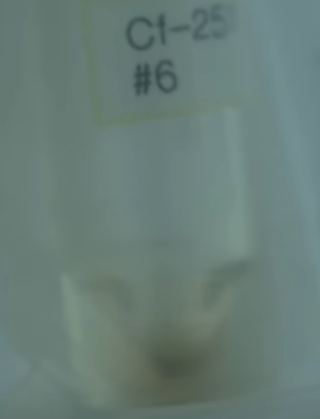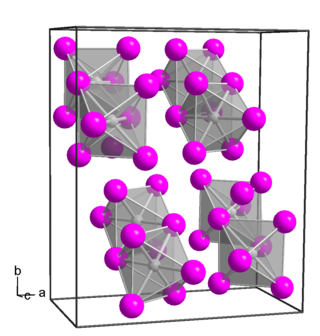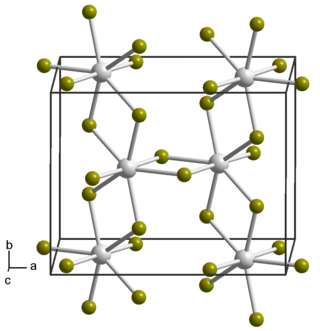Related Research Articles
The actinide or actinoid series encompasses at least the 14 metallic chemical elements in the 5f series, with atomic numbers from 89 to 102, actinium through nobelium. The actinide series derives its name from the first element in the series, actinium. The informal chemical symbol An is used in general discussions of actinide chemistry to refer to any actinide.

Einsteinium is a synthetic chemical element; it has symbol Es and atomic number 99. It is a member of the actinide series and it is the seventh transuranium element. It was named in honor of Albert Einstein.

Protactinium is a chemical element; it has symbol Pa and atomic number 91. It is a dense, radioactive, silvery-gray actinide metal which readily reacts with oxygen, water vapor, and inorganic acids. It forms various chemical compounds, in which protactinium is usually present in the oxidation state +5, but it can also assume +4 and even +3 or +2 states. Concentrations of protactinium in the Earth's crust are typically a few parts per trillion, but may reach up to a few parts per million in some uraninite ore deposits. Because of its scarcity, high radioactivity, and high toxicity, there are currently no uses for protactinium outside scientific research, and for this purpose, protactinium is mostly extracted from spent nuclear fuel.

Copper(I) iodide is the inorganic compound with the formula CuI. It is also known as cuprous iodide. It is useful in a variety of applications ranging from organic synthesis to cloud seeding.

Titanium tetraiodide is an inorganic compound with the formula TiI4. It is a black volatile solid, first reported by Rudolph Weber in 1863. It is an intermediate in the van Arkel–de Boer process for the purification of titanium.
Thorium(IV) iodide (ThI4) is an inorganic chemical compound composed of thorium and iodine. It is one of three known thorium iodides, the others being ThI3 and ThI2.

Few compounds of californium have been made and studied. The only californium ion that is stable in aqueous solutions is the californium(III) cation. The other two oxidation states are IV (strong oxidizing agents) and II (strong reducing agents). The element forms a water-soluble chloride, nitrate, perchlorate, and sulfate and is precipitated as a fluoride, oxalate or hydroxide. If problems of availability of the element could be overcome, then CfBr2 and CfI2 would likely be stable.

Many compounds of thorium are known: this is because thorium and uranium are the most stable and accessible actinides and are the only actinides that can be studied safely and legally in bulk in a normal laboratory. As such, they have the best-known chemistry of the actinides, along with that of plutonium, as the self-heating and radiation from them is not enough to cause radiolysis of chemical bonds as it is for the other actinides. While the later actinides from americium onwards are predominantly trivalent and behave more similarly to the corresponding lanthanides, as one would expect from periodic trends, the early actinides up to plutonium have relativistically destabilised and hence delocalised 5f and 6d electrons that participate in chemistry in a similar way to the early transition metals of group 3 through 8: thus, all their valence electrons can participate in chemical reactions, although this is not common for neptunium and plutonium.

Thorium(IV) nitrate is a chemical compound, a salt of thorium and nitric acid with the formula Th(NO3)4. A white solid in its anhydrous form, it can form tetra- and pentahydrates. As a salt of thorium it is weakly radioactive.

Zirconium(III) iodide is an inorganic compound with the formula ZrI3.

Holmium(III) iodide is an iodide of holmium, with the chemical formula of HoI3. It is used as a component of metal halide lamps.

Berkelium(III) iodide is a binary inorganic compound of berkelium and iodine with the chemical formula BkI3.
Einsteinium fluoride is a binary inorganic chemical compound of einsteinium and fluorine with the chemical formula EsF3.

Curium(III) iodide is the chemical compound with the formula CmI3. Since all isotopes of curium are only artificially produced, the compound has no natural occurrence.
Einsteinium(II) bromide is a binary inorganic chemical compound of einsteinium and bromine with the chemical formula EsBr2.
Berkelium(II) oxide is a binary inorganic compound of berkelium and oxygen with the chemical formula BkO.
Americium trihydride is a binary inorganic compound of americium and hydrogen with the chemical formula AmH3.

Platinum(IV) iodide is a inorganic compound with the formula PtI4. it is a dark brown diamagnetic solid and is one of several binary iodides of platinum.

Neptunium tetrabromide is a binary inorganic compound of neptunium metal and bromine with the chemical formula NpBr4.
Protactinium tetraiodide is a binary inorganic compound of protactinium metal and iodine with the chemical formula PaI4.
References
- ↑ Yaws, Carl L. (6 January 2015). The Yaws Handbook of Physical Properties for Hydrocarbons and Chemicals: Physical Properties for More Than 54,000 Organic and Inorganic Chemical Compounds, Coverage for C1 to C100 Organics and Ac to Zr Inorganics. Gulf Professional Publishing. p. 802. ISBN 978-0-12-801146-1 . Retrieved 3 April 2024.
- ↑ Brown, David; Canterford, J. H.; Colton, Ray (1968). Halides of the Transition Elements: Halides of the lanthanides and actinides, by D. Brown. Wiley. p. 229. ISBN 978-0-470-10840-6 . Retrieved 3 April 2024.
- ↑ Seaborg, Glenn T. (20 May 1994). Modern Alchemy: Selected Papers Of Glenn T Seaborg. World Scientific. p. 21. ISBN 978-981-4502-99-3 . Retrieved 3 April 2024.
- 1 2 3 David, Lore Rose (1953). Thorium: A Bibliography of Unclassified Literature. Technical Information Service. p. 18. Retrieved 3 April 2024.